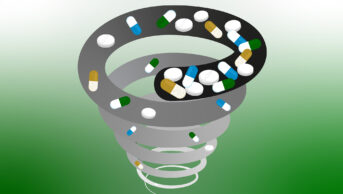
Shutterstock.com
The press and UK parliament keep a close eye on the results of the British Army’s compulsory drug testing of military personnel. In 2007, when the UK was engaged in military operations in Iraq and Afghanistan, the number of soldiers testing positive for cocaine — a class A drug with addictive and lethal potential — raised alarm and amounted to the loss of a battalion of 600 personnel.
Here, I recount the efficiency of the British Army’s targeted cocaine testing and the switch from cocaine to mephedrone that followed it. A retelling of this story is timely because in August 2017, after a major downsizing of the UK’s armed services, the BBC reported a high rate of positive compulsory drug test (CDT) results from British Army personnel on, or returning from, deployments[1]
.
Apparent increase in cocaine use
In 2007, while the UK’s military operations were winding down in Iraq but intensifying in Afghanistan[2]
, the UK press reported an apparent fivefold increase in the cocaine-positive rate of British soldiers (per 1,000 CDTs) between 2003 and 2007[3]
.
Were more personnel turning to cocaine to combat stress or, as the British Army maintained, were the results reflecting increased cocaine use in wider society? Or, as I suggested, was it actually possible to compare 2003 with 2007, like with like? The threshold for declaring cocaine positivity had been lowered to make declarations more likely. The British Army had become increasingly efficient in its targeting of CDTs; for example, by preferential testing of privates on Mondays and Tuesdays to catch out soldiers who had used cocaine during weekend leave[4]
.
| Year (% of all tests on Mondays) | Tests to the nearest 100 (Cocaine-positive rate per 1,000) | Number of expected cocaine-positives if rates were applied to equal number of CDTs (15,000) on Monday, Tuesday and Wednesday | ||
|---|---|---|---|---|
| Monday | Tuesday | Wednesday | ||
2003 (36%) | 19,200 (3.4) | 14,300 (3.0) | 9,600 (1.1) | 113 |
2005 (44%) | 23,000 (7.8) | 13,400 (8.2) | 10,500 (5.1) | 315 |
2007 (54%) | 24,500 (9.8) | 12,000 (7.3) | 5,800 (5.5) | 338 |
Table 1 shows the cocaine-positive rate per 1,000 CDTs among privates on Mondays, Tuesdays and Wednesdays during 2003, 2005 and 2007. The proportion of instances where all CDTs were conducted on a Monday increased between 2003 and 2007; the cocaine-positive rate was twice as high on Mondays as on Wednesdays, and the shift in the day-of-week pattern caused the cocaine detection rate to increase.
Table 1’s final column shows how many cocaine-positives would have been expected in 2003 to 2007 if each year’s weekday-specific cocaine-positive rates had been applied to an equal number of CDTs (15,000) on each of Monday, Tuesday and Wednesday. There was a threefold increase between 2003 and 2005, but this increase had already occurred by 2005, so it could not be ascribed to the greater intensity of military operations in Afghanistan during and following 2006.
My analyses impressed on me the efficiency of the British Army’s CDTs and the prudence of soldiers’ risk assessments — on return from weekend leave or from rest and recuperation after deployments — to ensure that they would not test positive for a class A drug such as cocaine.
I was so impressed that, in autumn 2009, when the legal high mephedrone made headline news, I approached Colonel Patrick Mercer OBE (then MP for Newark), with whom I had previously collaborated. Would he pose parliamentary questions to elicit the quarterly numbers of CDTs and cocaine-positive rate per 1,000 CDTs for 2008 and 2009?
| Year | Quarters | Number of CDTs | Number of cocaine-positive CDTs | Cocaine-positive rate per 1,000 (95% CI) |
|---|---|---|---|---|
2008 | Q1+2+3 | 64,650 | 339 | 5.2 (4.7 to 5.8) |
Q4 | 25,189 | 88 | 3.5 (2.8 to 4.2) | |
2009 | Q1+2+3 | 78,187 | 190 | 2.4 (2.1 to 2.8) |
Q1 | 24,762 | 47 | 1.9 (2.24) | |
CI: confidence interval | ||||
The results of Mercer’s parliamentary inquiry were quickly available and are summarised in Table 2, which shows that the cocaine-positive rate dropped from 5.2 (95% confidence interval [CI]: 4.7 to 5.8) per 1,000 CDTs in quarters 1–3 of 2008, to 2.4 (95% CI: 2.1 to 2.8) in 2009. But the fall began in the last quarter of 2008 (from 5.2 to 3.5 cocaine-positives per 1,000 CDTs) — a full year before the press furore in autumn 2009.
Statistical thinking
A soldier who made recreational use of cocaine on weekend leave would have had more reason than other users to switch from cocaine to mephedrone, because this drug was not made illegal until 2010, so it could not be tested for by the British Army. The magnitude of switching (from cocaine to mephedrone) by soldiers would be likely to be greater than in society more generally, but the time of switching would be more or less the same, and it had clearly happened by 2009. I therefore predicted that cocaine-related deaths in England and Wales would decrease in 2009 on account of the switch from cocaine to the less lethal mephedrone. But by how much?
To predict the scale of the decrease in cocaine-related deaths during 2009, we need to assess the magnitude of switching in society more generally. I consulted the British Crime Survey (now the Crime Survey for England and Wales) for reports on past-year use of cocaine by 16–24-year-olds. When 16–24-year-old respondents were asked about their past-year use of cocaine powder during the financial year 2010–2011, cocaine use was found to have dropped from 6.2% (95% CI: 5.7 to 6.7%) in 2007–2008 and 2008–2009 (based on 5,480 and 3,443 respondents) to 4.4% (95% CI: 3.7 to 5.1%) in 2009–2010; that is, by about 30%.
Some deaths are registered late in England and Wales because of the need for an inquest, so, meanwhile, we looked at deaths registered within five quarters of the quarter in which a death had occurred[5]
. Cocaine-related deaths occurred as follows: 182 in 2005; 169 in 2006; 219 in 2007; 204 in 2008; but only 148 in 2009, which accords with the 30% predicted decrease as a result of the societal cocaine-to-mephedrone switch by young people by 2009.
Use of cocaine powder has risen modestly since mephedrone was made illegal in 2010, but mephedrone use has decreased, possibly because users have become concerned about associated mental health problems. The latest Crime Survey for England and Wales shows that past-year use of cocaine powder was reported by 4.8% of 16–24-year-old respondents, while past-year use of mephedrone was reported by 0.3% (see Table 3)[6]
.
| Financial year | Unweighted base for 16–24-year-old respondents | Past-year use by 16–24-year-olds | |||
|---|---|---|---|---|---|
| Cocaine powder | Pooled 95% CI* | Mephedrone | Pooled 95% CI* | ||
2010–2011 | 3,607 | 4.4% | 4.3% (95% CI: 3.8 to 4.7%) | 4.4% | 3.9% (95% CI: 3.4 to 4.3%) |
2011–2012 | 3,474 | 4.1% | 3.3% | ||
2012–2013 | 2,678 | 3.0% | 3.6% (95% CI: 3.1 to 4.1%) | 1.6% | 1.7% (95% CI: 1.4 to 2.1%) |
2013–2014 | 2,681 | 4.2% | 1.9% | ||
2014–2015 | 2,296 | 4.8% | 4.6% (95% CI: 4.0 to 5.2%) | 1.9% | 1.4% (95% CI: 1.1 to 1.7%) |
2015–2016 | 2,379 | 4.4% | 0.9% | ||
2016–2017 | 2,457 | 4.8% | (95% CI: 4.0 to 5.6%) | 0.3% | (95% CI: 0.1 to 0.5%) |
CI: confidence interval | |||||
Questions left unanswered
In August 2017, BBC freedom of information researcher George Greenwood reported that the any-positive rate per 1,000 CDTs for soldiers on, or returning from, deployment has increased from around 4 per 1,000 CDTs in 2012–2013 (based on 19,500 CDTs on deployment, when around 189,000 personnel were deployed) to a high of 8 per 1,000 CDTs in 2016–2017 (based on 12,500 CDTs on deployment, when nearly 23,000 personnel were deployed)[1]
.
Over the period 2012–2013 to 2016–2017, there has clearly been a substantially increased CDT-rate on deployment (from 10 up to 54 CDTs per 100 personnel deployed), but the numbers deployed have decreased eightfold. We need more in-depth analysis of which drugs (cannabis, ecstasy, cocaine, steroids or opiates) the CDTs came back positive for, and whether testing on deployment still predominantly targets privates.
References
[1] Greenwood G. More soldiers failing drug tests on foreign deployments. 11 August 2017. Available at: http://www.bbc.co.uk/news/uk-40646365 (accessed January 2018)
[2] Bird SM, Fairweather CB. Military fatality rates (by cause) in Afghanistan and Iraq: a measure of the opposition. Int J Epidemiol 2007;36:841–846. doi: 10.1093/ije/dym103
[3] Bird SM. Compulsory drugs testing in the British Army: assessing the data. Royal United Services Institute (RUSI) Journal 2007;152:54–58. doi: 10.1080/03071840701863125
[4] Bird SM, Lynskey M, English C et al. Revisiting British Army Drug Testing, 2003-07: test thresholds, efficient targeting, and underlying trends. Journal of Royal United Services Institute (RUSI) 2008;153:16–23. doi: 10.1080/03071840802249406
[5] Bird SM. Editorial: Counting the dead properly and promptly. ‎J Royal Stat Soc 2013;176:815–817. doi: 10.1111/rssa.12035
[6] Broadfield D. Drug Misuse: Findings from the 2016/17 Crime Survey for England and Wales. Statistical Bulletin 07/17. July 2017. Home Office. Available at: https://www.gov.uk/government/statistics/drug-misuse-findings-from-the-2016-to-2017-csew (accessed January 2018)


